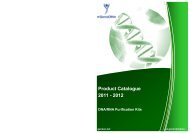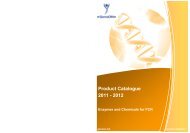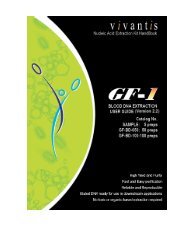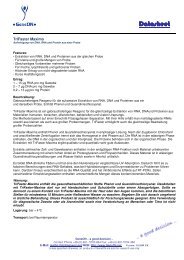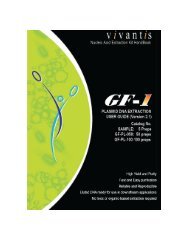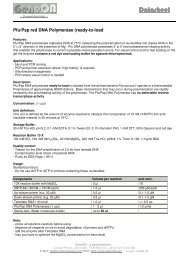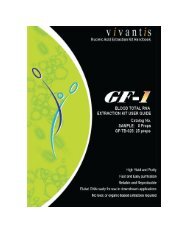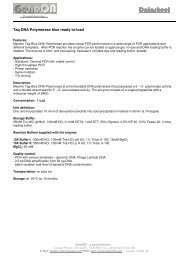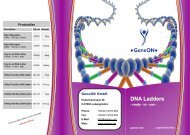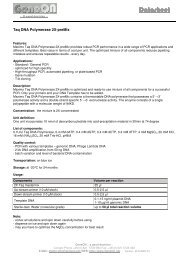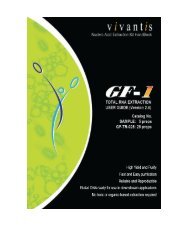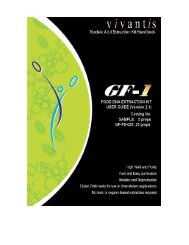Tissue DNA purification kit: Datasheet
Tissue DNA purification kit: Datasheet
Tissue DNA purification kit: Datasheet
Create successful ePaper yourself
Turn your PDF publications into a flip-book with our unique Google optimized e-Paper software.
Introduction<br />
The GF-1 <strong>Tissue</strong> <strong>DNA</strong> Extraction Kit is designed for rapid and efficient <strong>purification</strong> of<br />
genomic <strong>DNA</strong> from up to 5 x 10 6 cultured animal cells and various organs such as kidney,<br />
heart, lungs, brain, muscles, liver, spleen, etc without the need for precipitation or organic<br />
extractions. This <strong>kit</strong> uses a specially-treated glass filter membrane fixed into a column to<br />
efficiently bind <strong>DNA</strong> in the presence of high salt. This <strong>kit</strong> applies the principle of a minicolumn<br />
spin technology and the use of optimized buffers to ensure that only <strong>DNA</strong> is isolated<br />
while cellular proteins, metabolites, salts and other low molecular weight impurities are<br />
removed during the subsequent washing steps. High-purity genomic <strong>DNA</strong> is eluted in water<br />
or low salt buffers and has a A 260/280 ratio between 1.7 and 1.9 making it ready to use in many<br />
routine molecular biology applications such as restriction enzyme digestion, Southern<br />
blotting, PCR,<strong>DNA</strong> fingerprinting and other manipulations.<br />
Kit components<br />
Product<br />
Catalog No.<br />
5 Preps<br />
SAMPLE<br />
50 Preps<br />
GF-TD-050<br />
100 Preps<br />
GF-TD-100<br />
Components<br />
GF-1 columns 5 50 100<br />
Collection tubes 5 50 100<br />
<strong>Tissue</strong> Lysis Buffer 1.5ml 15ml 30ml<br />
(Buffer TL)<br />
Lysis Enhancer 0.1ml 1ml 2ml<br />
<strong>Tissue</strong> Genomic<br />
3.2ml 32ml 64ml<br />
<strong>DNA</strong> Binding<br />
Buffer (Buffer TB)<br />
Wash Buffer<br />
2.4ml 24ml 2 x 24ml<br />
(concentrate)*<br />
Elution Buffer 1.5ml 10ml 20ml<br />
Proteinase K* 0.11ml 1.05ml 2 x 1.05ml<br />
Handbook 1 1 1<br />
* Please refer to Reconstitution of Solutions and Storage and Stability before using this <strong>kit</strong>.<br />
The GF-1 <strong>Tissue</strong> <strong>DNA</strong> Extraction Kit is available as 50 and 100 <strong>purification</strong>s per <strong>kit</strong>.<br />
The reagents and materials provided with the <strong>kit</strong> are for research purposes only.
Note: The GF-1 <strong>Tissue</strong> <strong>DNA</strong> Extraction Kit is optimized to isolate up to 20µg of <strong>DNA</strong> from up to<br />
5 x 10 6 cultured animal cells or 10 - 20mg of tissue samples. <strong>Tissue</strong> samples vary in the number of<br />
cells depending on age, type of tissue and origin. When processing samples, do not use more than the<br />
recommended starting material as excessive number of cells will overload the column. This would<br />
result in reduced yield and purity. We recommend weighing the tissue samples before starting to<br />
ensure optimum yield and purity is obtained. Liver and spleen are very high in protein and RNA<br />
content. Thus, when isolating genomic <strong>DNA</strong> from these sources, use only up to 15mg of the sample.
Additional Materials to be Supplied by User<br />
Absolute Ethanol (>95%)<br />
RNase A (DNase-free) (20mg/ml)<br />
Phosphate Buffered Saline (PBS)<br />
Reconstitution of Solutions<br />
The bottle labeled Wash Buffer contains concentrated buffer which must be diluted with<br />
absolute ethanol (>95%) before use.<br />
For SAMPLE (5 preps),<br />
Add 5.6ml of absolute ethanol into the bottle labeled Wash Buffer.<br />
For GF-TD-050 (50 preps),<br />
Add 56ml of absolute ethanol into the bottle labeled Wash Buffer.<br />
For GF-TD-100 (100 preps),<br />
Add 56ml of absolute ethanol into one of the bottles labeled Wash Buffer.<br />
Add 56ml of absolute ethanol into the other bottle labeled Wash Buffer only prior to use.<br />
Store Wash Buffer at room temperature with bottle capped tight after use.<br />
Storage and Stability<br />
• Store solutions at 20°C - 30°C.<br />
• Store Proteinase K at -20°C.<br />
• Kit components are guaranteed to be stable for 12 months from the date of manufacture<br />
Buffer TB may exhibit salt precipitation due to cold temperature. If this occurs, simply<br />
warm the bottle at 55°C - 65°C with occasional mixing until precipitate is completely<br />
dissolved.
Chemical Hazard<br />
Buffer TB contains guanidine salts which can be harmful when in contact with skin or<br />
swallowed. Always wear gloves and practice standard safety precautions. Do NOT disinfect<br />
guanidine or extraction waste in solutions containing bleach or any other form of acid. To<br />
clean any items contaminated with the reagent, simply soak in detergent and water to remove<br />
all traces of guanidine before cleaning with bleach or acidic solutions.
Procedures<br />
Reminder<br />
• All steps are to be carried out at room temperature unless stated otherwise.<br />
• Wash Buffer (concentrate) has to be diluted with absolute ethanol before use. Please<br />
refer to Reconstitution of Solutions.<br />
• If precipitation forms in Buffer TB, incubate at 55°C - 65°C with occasional mixing until<br />
precipitate is completely dissolved.<br />
Pre-set waterbath to 65°C.<br />
Pre-heat Elution Buffer at 65°C.<br />
A. <strong>DNA</strong> Extraction from Cultured Animal Cells<br />
1. Centrifugation and resuspension<br />
Pellet appropriate amount of cells (maximum 5 x 10 6 ) in a clean microcentrifuge tube<br />
by centrifugation at 800 x g for 5 min at 4°C. Decant the supernatant. Add 200µl of<br />
PBS and resuspend completely by pipetting.<br />
If frozen cells pellet is used, thaw the cells completely on ice before adding PBS.<br />
2. Cells lysis<br />
Add in 20µl of Proteinase K and 2µl of Lysis Enhancer to the sample and mix<br />
immediately. Add 200µl of Buffer TB and mix thoroughly by pulsed-vortexing.<br />
Incubate at 65°C for 10 min. Proceed to Step 4.
B. <strong>DNA</strong> Extraction from Animal <strong>Tissue</strong><br />
1. <strong>Tissue</strong> preparation<br />
Cut 10 - 20mg of tissue sample into small pieces with a clean scalpel.<br />
The tissue sample can be ground into fine powder using liquid nitrogen with a pestle<br />
and mortal for more efficient lysis.<br />
2. <strong>Tissue</strong> lysis<br />
Add 250µl of Buffer TL and 20µl of Proteinase K to the sample. Mix thoroughly by<br />
pulsed vortexing to obtain a homogeneous solution. Add 12µl of Lysis Enhancer and<br />
mix immediately. Incubate at 65°C for 1-3hr (or overnight if tissue mixture does not<br />
appear clear) in a shaking waterbath or mix occasionally during incubation to ensure<br />
thorough digestion of the sample.<br />
If tissue sample has not been reduced to small pieces, homogenize sample in Buffer TL with<br />
multiple strokes using a tube pestle. Solubilization of tissue sample varies between different<br />
tissue types. If insoluble materials still remain, extent incubation time or increase the amount of<br />
Proteinase K to ensure complete lysis.<br />
Optional: Removal of RNA<br />
If RNA-free <strong>DNA</strong> is required, add 20µl of RNase A (DNase-Free, 20mg/ml). Mix and<br />
incubate at 37°C for 10 min.<br />
3. Homogenization<br />
Add 2 volumes (~560µl without RNase A treatment, ~600µl with RNase A treatment)<br />
of Buffer TB and mix thoroughly by pulsed-vortexing until a homogeneous solution is<br />
obtained. Incubate 10 min at 65°C.<br />
4. Addition of ethanol<br />
Add 200µl of absolute ethanol. Mix immediately and thoroughly by pulsed-vortexing to<br />
obtain a homogeneous solution.<br />
Mix immediately to prevent any uneven precipitation of nucleic acid due to high local ethanol<br />
concentrations.
5. Loading to column<br />
Attention! Tips for Higher Yield<br />
In order to obtain maximum yield, we strongly recommend users to fix the orientation of the<br />
column during centrifugation at all times. We recommend users to place the column which has<br />
a triangle mark on the edge, at a fixed position during centrifugation.<br />
Transfer approximately 600µl of sample into a column assembled in a clean collection<br />
tube (provided). Centrifuge at 5,000 x g for 1 min. Discard flow through. Repeat for the<br />
remaining sample from step 4.<br />
6. Column washing<br />
Wash the column with 750µl Wash Buffer and centrifuge at 5,000 x g for 1 min.<br />
Discard flow through. Repeat column washing once again.<br />
Ensure that ethanol has been added into the Wash Buffer before use (refer to Reconstitution of<br />
Solutions).<br />
7. Column drying<br />
Centrifuge the column at 10,000 x g for 1 min to remove all traces of ethanol.<br />
8. <strong>DNA</strong> elution<br />
Place the column into a clean microcentrifuge tube. Add 200µl of preheated Elution<br />
Buffer, TE buffer or sterile water directly onto column membrane and stand at room<br />
temperature for 2 min. Centrifuge at 5,000 x g for 1 min to elute <strong>DNA</strong>. Store <strong>DNA</strong> at<br />
4°C or -20°C.
Troubleshooting<br />
Please note that by not adhering to the recommended protocols, unsatisfactory results related<br />
to yield and quality of <strong>DNA</strong> may occur. If problems arise, please refer to the following:<br />
Problem Possibility Suggestions<br />
Problem<br />
Low <strong>DNA</strong> yield<br />
Sample not thoroughly<br />
homogenized<br />
Samples not fresh or not<br />
properly stored<br />
Ensure that tissues are<br />
completely homogenized in<br />
Buffer TL<br />
For long term storage of tissues,<br />
keep at -70°C.<br />
Sample not lysed completely Ensure that tissues are<br />
completely homogenized in<br />
Buffer TL, Proteinase K<br />
and Lysis Enhancer, mix<br />
sample frequently during<br />
incubation in the absence of a<br />
shaking waterbath<br />
Ensure that cultured animal<br />
cells are completely<br />
homogenized in PBS,<br />
Proteinase K, Lysis Enhancer<br />
and Buffer TB, mix until<br />
homogeneous by<br />
pulsed-vortexing before<br />
incubation at 65°C.<br />
Proteinase K activity is<br />
decreased<br />
Low elution efficiency<br />
Ensure that Proteinase K is<br />
stored at -20°C.<br />
Pre-heat Elution Buffer to<br />
65°C-70°C before eluting <strong>DNA</strong>.<br />
Incubate column at room<br />
temperature for 2 min after<br />
addition of Elution Buffer.<br />
Column clogged<br />
Refer to Problems under<br />
'Column clogged'.
Problem Possibility Suggestions<br />
Low purity<br />
(A260/280)<br />
Column not placed at fixed<br />
orientation during<br />
centrifugation<br />
Incomplete protein<br />
denaturation<br />
Proteinase K activity is<br />
decreased<br />
Place the column which has a<br />
triangle mark on the edge, at a<br />
fixed position during<br />
centrifugation at all times.<br />
Use fresh Proteinase K and<br />
extend incubation time until<br />
lysate clears.<br />
Refer to problem "Low <strong>DNA</strong><br />
yield".<br />
Column clogged Overloading of column Do not use more than<br />
recommended amounts of<br />
sample material. If any<br />
undigested material remains,<br />
spin to remove tissue lysate and<br />
transfer supernatant into a new<br />
microcentrifuge tube.<br />
<strong>DNA</strong> degradation/<br />
smearing<br />
Poor performance<br />
of eluted <strong>DNA</strong> in<br />
downstream applications<br />
<strong>DNA</strong> sheared during<br />
<strong>purification</strong><br />
Sample too old<br />
Sample frozen and thawed<br />
repeatedly<br />
Eluted <strong>DNA</strong> contains traces<br />
of ethanol<br />
TE buffer is used to elute<br />
<strong>DNA</strong>. EDTA in TE buffer<br />
may inhibit subsequent<br />
enzymatic reaction<br />
After the addition of Buffer TL<br />
and Proteinase K, avoid<br />
vigorous mixing and<br />
pipetting. Use cut-off tip if<br />
lysate appeared viscous.<br />
<strong>DNA</strong> already degraded in old<br />
sample.<br />
Avoid repeated freeze-thaw<br />
cycles.<br />
Ensure that the Column drying<br />
step is carried out prior to<br />
elution.<br />
Use Elution Buffer or water<br />
with a Ph range of 7.0 - 8.5.



